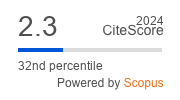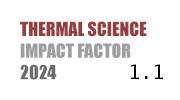THERMAL SCIENCE
International Scientific Journal
Thermal Science - Online First
online first only
Main pathways for the emergence of optimized air cavity brick walls
ABSTRACT
The application of innovative construction techniques, such as the use of bricks with interconnected and well-arranged cavities, can promote enhanced insulation. Two hundred and forty-four different configurations were investigated thermally to improve their thermal performance and to promote some design guidelines. A configuration will then be selected to evaluate the thermal performance of facade walls based on several geometric morphologies, according to which they are either single or double walls. The selected house has been subjected to the climatic conditions of Ghardaia, which are hot and very severe during certain periods. The method for calculating the building's energy needs was applied to assess the energy required for heating and cooling according to the level of building compactness. The results initially indicated that longitudinal cavities improve the thermal resistance of hollow bricks and thus reduce the heat flow passing through the façade walls, while transverse walls decrease the thermal performance of these hollow bricks by creating thermal bridges within their structure. Adopting construction techniques that promote insulation, such as double walls can be beneficial. For buildings requiring thermal comfort, double-wall structures or more advanced insulation systems are generally recommended. The double-wall design helps reduce heating and cooling needs, resulting in significant energy savings of up to 36%. A compact design can lead to energy savings and a reduction in insulation needs, while still maintaining adequate thermal comfort.
KEYWORDS
PAPER SUBMITTED: 2025-03-13
PAPER REVISED: 2025-04-19
PAPER ACCEPTED: 2025-04-25
PUBLISHED ONLINE: 2025-07-05
- Vera, S., et al., Improvement of the thermal performance of hollow clay bricks for structural masonry walls, Construction and Building Materials 415 (2024), 135060
- Hamdani, M., et al., A new modelling approach of a multizone building to assess the influence of building orientation in Saharan climate, Thermal Science 19 Suppl 2 (2015), pp. S591-S601
- Cherier, M.K., et al., Impact of glazing type, window-to-wall ratio, and orientation on building energy savings quality: A parametric analysis in Algerian climatic conditions, Case Studies in Thermal Engineering 61 (2024) 104902
- Cherier, M.K., et al., Energy efficiency and supplement interior comfort with passive solar heating in Saharan climate, Advances in Building research (2018), pp. 94-114
- Esmeray, E., Mustafa, A., Utilization of sewage sludge, oven slag and fly ash in clay brick production, Construction and Building Materials 194 (2019), pp. 110-121
- Remesar, J.C., et al., Improved balance between compressive strength and thermal conductivity of insulating and structural lightweight concretes for low rise construction, Construction and Building Materials 247 (2020) 118448
- Chen, R., Liu, H., Numerical simulation and optimization of construction: Product prototyping of new raw earth-based energy-saving hollow bricks, Journal of Building Engineering 70 (2023) 106456
- Shibib, K.S., et al., Enhancement in Thermal and Mechanical Properties of Bricks, Thermal Science 17.4 (2013), pp. 1119-1123
- Ahmad, A., Al-hadhrami. L.M., Thermal performance and economic assessment of masonry bricks, Thermal Science 13.4 (2009), pp. 221-232
- Laaroussi, N., et al., An example of comparison between ISO Norm calculations and full CFD simulations of thermal performances of hollow bricks, Journal of Building Engineering 11 (2017) pp. 69-81
- ***, Règles Th-bat - Parois opaques, rt-re-batiment.developpementdurable.gouv.fr/, rt-re-batiment.developpement-durable.gouv.fr/IMG/pdf/4-fascicule_parois_opaques_methodes.pdf
- Makrygiannis, I., Karalis, K., Optimizing building thermal insulation: the impact of brick geometry and thermal coefficient on energy efficiency and comfort, Ceramics 6 (2023) pp. 1449-
- Hou, C., et al., Effect of the insulation materials filling on the thermal performance of sintered hollow bricks under the air-conditioning intermittent operation, Case Studies in Construction Materials 8 (2018) 217-225
- Magrini, A., et al., Air cavity building walls: a discussion on the opportunity of filling insulation to support energy performance improvement strategies, Energies 15 (2022), 8916
- Rebzani M.B., et al., Réglementation Thermique du Bâtiment C 3.2 et C 3. 4, Document Technique Réglementaire CNERIB, Ministère de l'habitat., Algérie, Jun-2011
- Belgherras, S., et al., Prospective analysis of the energy efficiency in a farm studio under Saharan weather conditions, Energy and Buildings 145 (2017) pp. 342-353
- Hamdani, M., et al., Judicious method of integrating phase change materials into a building envelope under Saharan climate, International Journal of Energy Research (2021) pp. 1‐18
- Bendara, S., et al., Energy efficiency and insulation thickness according to the compactness index case of a studio apartment under saharan weather conditions, Journal of Solar Energy Engineering 141.4 (2019) pp. 041011
- Bekkouche, S.M.A., et al., Thermal resistances of local building materials and their effect upon the interior temperatures case of a building located in Ghardaïa region, Construction and Building Materials 52 (2014) pp. 59-70
- Kadraoui, H., Diagnostic et solutions adaptées pour l'amélioration de l'efficacité énergétique d'une construction multizone énergivore, PhD in Renewable Energies (in French), Abou-Bekr Belkaid University - Tlemcen, Algeria, 2019
- ***, Méthode de calcul 3CL-DPE 2021 (Logements existants), rt-rebatiment.developpementdurable.gouv.fr/IMG/pdf/consolide_annexe_1_arrete_du_31_03_2021_relatif_aux_methodes_et_procedures_applicables.pdf
- Amiel, M., Méthode pour une optimisation du diagnostic de performance énergétique via une approche instrumentée, PhD in Civil Engineering and Housing Science (in French), Université Savoie Mont Blanc, 2020
- Bienvenido-Huertas, D., et al., A comparative analysis of the international regulation of thermal properties in building envelope, Sustainability 11 (2019) pp. 5574

